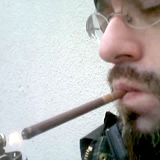Change minds, change reality. That’s what people are saying, right? Human minds create the reality they live in, and a little faith is the most powerful thing in the universe….
It sounds beautiful and hopeful, doesn’t it? We experience the whole of reality — or rather the tiny slice of that whole that we can actually perceive — through our brains’ interpretations of our senses. Doesn’t it make sense that if we change how our minds work, it changes our experience of the world, which is effectively changing the world, at least for us personally, and for anyone else we can convince?
Sure. And cranking up the brightness on our televisions makes the world a brighter place.
Let me give you two scenarios. Two people, who are nearly identical, who have the same dream. They both decided at a young age that they really love dragons and they want them to be real.
Please note: for the duration of this exercise I am leaving out the question of the wisdom of pursuing this dream.
In the first scenario, our dreamer concentrates on the imagery of dragons: what they look like, what various landscapes would look like with dragons included, either flying in the sky or perched on the tops of sturdy buildings or distant mountain peaks. Eventually he learns to see them anywhere and everywhere. Nearby hawks in the sky, patrolling for squirrels and loose house-pets, look like stratospheric dragons. Certain peaks look like perched dragons. Or maybe that entire mountain range is a huge one in repose. Many clouds are also dragons, bringing beauty or fury at whim.
After many years of looking, he discovers he has been surrounded by dragons all along, and now he is happy.
In our second scenario, our dreamer focuses on old stories and legends, descriptions, and tales of their fantastical exploits. A lot of old fables have roots in actuality, even if weak, distant, and thready. She also explores the wealth of data on dinosaurs and the birds that have descended from them evolutionarily. She goes to college and gets degrees in genetics and evolutionary biology, and gets funding to replicate the experiments to reactivate genes on chickens to get them to express teeth and tails. Fifteen years into her plan, she sits stymied, waiting for funding and ethical approval to explore further and research how to create organisms to order, either for commercial purposes or to fill niches in endangered ecosystems where extinctions have left things unbalanced and threaten diversity — for which a dragon, possible within five more years of research and experimentation, might be the perfect answer.
She’s not happy at the moment, and she might never be, depending on funding and legislation, but she’s a lot closer to real dragons than our first dreamer, who has made himself happy by torquing his mind with a near-delusion.
Does it sound like I’m judging? Maybe I’m judging.
It’s easier to make yourself happy by disconnecting from reality and indulging in a little self-delusion, but in my view that’s a little selfish. For instance, maybe other people want dragons to exist too but lack the imagination to be satisfied by insubstantial metaphors. Maybe other people are fairly desperate for dragons to not exist — but will still be impressed and inspired by your success if you pull it off.
Wishcraft, prayer, positive thinking — that’s all just cranking the knobs on the television. And it’s all a little necessary, because 1) it’s good to have your own hand on your knobs, so to speak, and 2) sometimes the setting you thought was normal is just too dark, and 3) why the hell shouldn’t you make yourself happy now and then as long as you have the option?
But seriously, it’s revving the engine while you have the clutch down. You don’t go anywhere no matter how powerful the engine sounds. If you want to move — really move — you have to have your gears engaged with reality. You have to wave the mists and fogs of faith and hope away and see what’s really there, and then you have to do all the tedious work that takes you from where you are — once you can see where you really are — to where you want to go. And being work, you don’t get to be happy until it’s over — which is why it’s awesome to set a lot of little goals and take a lot of breaks so you don’t get tired and succumb to despair.
The universe is huge and functionally infinite in terms of potential and possibility. There isn’t much of a limit to the things that we can make with the components at hand, even if we start out in the direction of what we were firmly convinced was impossible at the outset. But we won’t ever bring our dreams to fruition if we waste all of our energy wishing really hard and begging for our desires to fall into our laps like a dog under God’s dinner table. All we can do that way is make ourselves happy with the idea of crumbs. We short-circuit actual success by finding a way to pretend we already have it.
Engagement of the gears with reality means preparing to be unhappy, preparing to sweat, to get dirty, to earn a few smashed fingers and blisters, and preparing for opposition from people who think your goals are stupid. If you don’t feel that load on the system, then you’re spinning your wheels and playing with the fairies in your head.
Nothing says you won’t get help from surprising directions, but don’t count on it.
[*]
From The prolongation of the lifespan of rats by repeated oral administration of [60] fullerene:
…
3.3. Chronic toxicity and effects of C60 on lifespan of rats
Fig. 3 shows the animal survival and growth. After ï¬ve months of treatment (M15) one rat treated with water only exhibited some palpable tumours in the abdomen region. Due to the rapid development of tumours (about 4 cm of diameter) this rat died at M17. As rats are known to be sensitive to gavages, we decided to stop the treatment for all rats and to observe their behaviour and overall survival.
All remaining animals survived with no apparent sign of behavioural trouble until M25 (Fig. 3a). At the end of M25 the animals of the control groups showed signs of ulcerative dermatitis with ageing while C60-treated animals remained normal. As the growths of all surviving animals showed no signiï¬cant difference until M30 (Fig. 3b) indicating that the treatment did not alter their food intake, we continued observing their survival.
At M38 all water-treated control rats were dead (Fig. 3a). This agrees with the expected lifespan of this animal species that is thirty to thirty six months. At this time 67% of olive-oil-treated rats and 100% of C60-treated rats were still alive.
The survival distributions for C60-olive oil-treated rats and controls were estimated by the non-parametric Kaplane–Meier estimator (Fig. 3) and compared by a log-rank estimated test. The estimated median lifespan (EML) for the C60-treated rats was 42 months while the EMLs for control rats and olive oil-treated rats were 22 and 26 months, respectively. These are increases of 18 and 90% for the olive-oil and C60-treated rats, respectively, as compared to controls.
The log-rank test leads to Χ2 values (one degree of freedom) of 7.009, 11.302, and 10.454, when we compare water-treated and olive oil-treated rats, water-treated and C60-treated rats, and olive oil-treated and C60-treated rats, respectively. This means that olive oil extends the lifespan of rats with respect to water with a probability of 0.99 while C60-olive oil extends the lifespan of C60-treated rats with a probability of 0.999 and 0.995 with respect to water and olive oil treatments, respectively.
…
So I guess doubling the expected lifespan of a lab rat after seven months of daily dosing counts as no measurable levels of toxicity to C60 buckyballs. Hunh.
[*]
____________
Baati T, et al., The prolongation of the lifespan of rats by repeated oral administration of [60]fullerene, Biomaterials (2012), doi:10.1016/j.biomaterials.2012.03.036
Related posts:
Home is a dimly lit expanse of cold rocky sand on a miles-broad ledge on a high mesa. The air is unnatural thick soup of argon, neon, nitrogen, oxygen, water vapor, carbon dioxide, and a lovely tinge of methane and ammonia that gets worse as one climbs higher. Out here, halfway down the slopes, people come out and breathe it on purpose, seeking their own level of balance between remaining functional and giddy, stupefying inert gas narcosis. Miles further down are the ponderous waves of the slow-motion ocean that splash and gnaw at even the highest slopes. Gravity is high, but the dense soup provides plenty of buoyancy. Outside on the ledge any tiny child speaks with a creepy basso profondo that carries for miles.
“Earthlike” said the brochure more than two hundred years ago. “Earthlike” on a cosmic scale leaves abundant room for nuance. “Breathable atmosphere” it boasted, referring, as it turned out, to a vaguely half-mile-thick layer granting access to a couple of percent of the unsubmerged surface, not pointing out that the layer can shift up or down by a couple of miles over the course of three or four days at the whim of demonic weather driven by the tidal forces of a massive speed-demon moon. Many, many liberties were taken with the word “breathable.” Breathable, maybe, alternately by hyperoxy or laugher euphoriacs who bring their drum clubs out to the very edge of the ledge to be licked by the icy, syrupy salt spray from the growling sea, booming away in call and response to the distant ocean’s own rhythms, each group competing to see which can best commune with the spirit of this place.
Speaking of, there’s something alive in the water. Or maybe the water itself is alive. How do you draw a line between a snail and its shell? Certainly it’s not currents or tides that makes the plumes of water reach our shelf, or even higher. This ocean is even more like unbound cytoplasm than the samples of the seas we brought here from Earth for comparison.
At least the ledge is warm, balmy and unchanging all year long. This place has no seasons.
Eight generations it took to arrive still alive to our little outpost in the afterlife, gradually drifting the gravity, the air mixture, and the lighting to try to ease the shock of arrival. We had to change our target points a hundred times in the course of our trip as we got better ideas of where we would have to settle on Earth’s “twin” and what the blue starlight would look like filtered through clouds of ammonia and methane crystals, strobed by very impressive lightning. We sang like whales to one another down the hallways through the muck we tried to learn to breathe. We were insane to the level of our constituent cells by the time we got here and snaked down the cable for the elevator. Two generations have been born here, and the youngest still have attacks of uncontrollable laughing and terrifying hallucinations.
Every ten or twenty years or so after we left Earth was supposed to lob a care package out after us, strung out on a line behind us like beads. We should have gotten two or three of them by now. Info updates on scientific advancements we wouldn’t have the resources to discover ourselves. Third and fourth priority seed banks. Chocolate and coffee, just in case. Letters from family left behind. None of them have shown up.
Last time I took the week-long ride up the lift, I went straight to the observatory, like everyone else does, and looked at the scope-image of old Sol, 295 years in this world’s past. The people there, if there still are any, won’t spot the light from our landing flare for another 245 years. And from their view it took us 350 years to get here. From ours, it was about half that. The light we see is still T+200 years or so, but we’re long past the range of being able to discern any kind of intelligent signal against the background. We are alone and cut off.
Why are we even here?
The oldest of us are great-great-grandchildren of anyone who signed up for this voluntarily. Even if we refitted and fueled up and high-tailed it home, it would be our own descendants trying to make sense of whatever it was they found there, the better part of a thousand years after the last word from them we ever heard, less a few hundred years of time dilation. On the path things were on, even a hundred years could make for incomprehensible changes. For all we know, they worked out FTL travel and have agents here ahead of us that we’ve yet to find. For all we know, civilization collapsed completely and any contemplation of space travel is taboo, and we are near-forgotten myths at best.
And now that we are here, the ocean reaches higher for this ledge than it does anywhere else on the planet, far higher than it ever did in our surveys before we came down. Once every couple of weeks someone jumps — but there’s no way they could make it out far enough to hit the water before they hit the sloping cliff-face below. Every couple of weeks a small team suits up and rappels down to retrieve a body, successful as often as not. Sometimes the jumper times it right when a surge comes up to grope at the edge, and maybe, just maybe, the ocean accepts its gift and carries it back down to its bosom.
Forty years. A thousand jumpers. Five hundred corpses retrieved and processed and fed to the gardens. Five hundred lost, too far down to find or recover, or perhaps dissolved into the frigid soup. Maybe all of that reaching up of the surge is an attempt to grab a few more. Or put back the ones we have given it.
I am the first one the sea ever gave back.
[*]
Keep your fist to the ground and your ear to the grindstone. I have no idea what you’re supposed to do with your nose. It can’t be comfortable or healthy. But keep all your arrows sharp and the shafts tightly curved so they come back to you when you launch them. Test them on your skin and feed them your blood so they’ll know where home is.
That’s how you endure criticism — be your own worst enemy and so self-absorbed that no one else could ever do worse damage to you than your own contortions. Keep a live hive of bees in your chest and kick yourself from time to time to keep them angry. If any honey drips out of your various wounds, let it leave an undisturbed trail behind you.
You are made of angry bees, a walking waxwork in the shape of a wasp. The buzzing fills you with secret messages from white-noise voices and booty-shake dances reminding you of distant flowers. Somewhere in there is a queen, pampered and protected, dutifully laying eggs, waiting to be surprised with a battle to the death with a newer, sexier model. The new replacement is already squirming in one of the thousands of honeycomb cells in your brain, squirming with all the other identical larvae, being fed special poisons by traitors in the internal ranks.
Your hive is a single animal, animal. That’s what it’s like to live in a brain made out of meat in a body made out of meat. A thousand buzzing, booty-shaking voices. Which of them is your “me”?
You can feel the buzzing at the back of your skull and in your teeth, can’t you? How can you stand it?
Oh, that’s right. You can’t.
This is why you need me. I’m the only one who can outvote them all with a stinging slap. I’m the one who can unscramble your metaphors and straighten your arrows. I bend your bow and string it and keep it firmly in your grip.
I know you hate it. But look at all we’ve accomplished, just today. You’ve written three pages of lyrics. You fed yourself a bowl of kibbles and got dressed and left the house. You bought a ten-dollar cigar because you’ve never had one. You bought and brought home six neon tetras and a pleco to repopulate the tank you’ve let die twice now, and they’re floating in their little baggies, acclimating. You bought six boxes of ammo for the 30-30 and a pack of 50 paper targets for the look of it. You even remembered all on your own that you needed fuel for the Zippo.
I even made you put down the newspaper you were going to buy, because no one needs to get caught up on current events the same day they buy 120 rounds for a rifle. That would have been irresponsible. Keep all seven fish alive for a week and I’ll let you get a paper.
Four pounds of fresh cherries was a much better buy, considering you’re on food stamps and a disability pension.
Do you remember where you were when you drank from the well of forgetting? Thirty miles from a river bed that’s been dry for thousands of years, pockets full of dirt rich in ancient anthrosols and spent hulls from seeds that haven’t been used to fuel humanity in the region for more than twice thirty centuries, no sign of any of the rest of your platoon, no dog tags, name and all identifying badges ripped from your BDUs, beltless and barefoot and a bit more than thirty pounds too skinny. Thirty weeks missing from duty, not quite thirty years missing from your memory.
Helpful people locked you up for a little while, gave you a name, and mercifully decided you’d been kidnapped and that you’d managed to escape. They gave you a box of stuff they said was yours, and medical discharge papers, and sent you “home” to where no one knew you and you knew no one. And they gave you to me, chock full of little buzzing bees.
And no way to tell which of them is the old you, or even the current you, or which of them is me.
[*]
So I’ve been thinking.
Somewhere within a few hundred light years of here is where our sun formed around 4.6 billion years ago, and, with it, the rest of our solar system, condensing out of a bit of molecular-cloud-fluff thought to be about 3000 solar masses of largely hydrogen and helium. Probably a large number of stars are siblings to us in the nebula that was our nursery.
It’s been a while, so we’ve all drifted apart a bit since then. And quite a number of our more massive siblings have already snuffed it, as it were.
I carry a lump of iron in my pocket that’s as old as any of the iron we dig out of the ground. It’s a recent arrival, having landed on Earth back in 1947. I’d say it’s about as old as the iron that makes up the planet Mercury. Or the stuff that makes up Earth’s core. The Sun didn’t make it. It’s not old enough or big enough or dead enough. When Sol finally cools down trillions of years from now, it will be a huge oxygen-frosted diamond. That’s as far at it will ever get, fusion-wise. Any iron we have, and any of the elements heavier than iron, came from the super-huge progenitor stars that blew up to make our nursery nebula — or at least salt the huge molecular cloud with all of the heavy elements we grew up with.
So far so good, right?
When huge stars supernova, some of them, anyway — in particular, the ones that fling out chunks of iron and heavier elements like gold and uranium — they do so in a huge explosion that basically turns them inside-out. As part of the process, they eject a core of super-dense neutronium. Or a black hole.
Current theory says there were around ten supernovae salting the nursery with heavy elements, though I’m not really sure what math backs that up. But, given that, that means there are around ten or so neutron stars and/or black holes whizzing around in our local neighborhood (a hundred million to a billion in the Milky Way galaxy in general), slowly evaporating and/or making themselves a menace and/or generally lurking in the dark, biding their time. We can see them as X-ray sources when they’re feeding. But when they’re not?
In the last five to ten million years, the solar system has been traveling through a cavity in the interstellar medium called the Local Bubble — a space cleared out by yet another supernova or two ten to twenty million years ago. The bubble is about 300 light years across, meaning, basically, there’s even less interstellar medium in here with us to eat than usual. About a tenth of Milky Way average.
So what I’m wondering is what the odds are that there is a dark core of one of our parents/progenitors — or possibly a more massive sibling or neighboring cousin with a much shorter lifespan — in here with us in the Local Bubble, stalking along behind us, shadowing us like a monster in the closet or under the bed.
[*]
Categories
Archives
- January 2018
- January 2016
- June 2015
- May 2014
- January 2014
- October 2013
- June 2013
- April 2013
- March 2013
- February 2013
- November 2012
- October 2012
- September 2012
- August 2012
- July 2012
- June 2012
- May 2012
- April 2012
- March 2012
- February 2012
- January 2012
- December 2011
- November 2011
- October 2011
- September 2011
- August 2011
- July 2011
- June 2011
- May 2011
- April 2011
- March 2011
- February 2011
- January 2011
- December 2010
- November 2010
- October 2010
- September 2010
- August 2010
- July 2010
- June 2010
- May 2010
- April 2010
- March 2010
- February 2010
- January 2010
- December 2009
- November 2009
- October 2009
- September 2009
- August 2009
- July 2009
- May 2009
- March 2009
- February 2009
- December 2008
- November 2008
- October 2008
- September 2008
- August 2008
- July 2008
- June 2008
- May 2008
- April 2008
- March 2008
- February 2008
- January 2008
- December 2007
- November 2007
- October 2007
- September 2007
- August 2007
- July 2007
- June 2007
- May 2007
- April 2007
- March 2007
- February 2007
- January 2007
- October 2006
- September 2006
- July 2006
- June 2006
- May 2006
- April 2006
- March 2006
This One Time
-
This One Time, 75
This one time I was running through the airport and everyone was screaming. Well, not everyone, just a few good representative samples of any particular clump, but the effect was a constant squealing and roaring that was the kind you eventually start screening out and ignoring because it doesn’t actually convey any information anymore, like […]
-
This One Time, 75
-
Recent Posts
Recent Comments
- Saia on The Little Gift Shop in the Vestibule of Hell
- Saia on The Little Gift Shop in the Vestibule of Hell
- Davelifestyle on Out in the Yard
- Davelifestyle on About
- xalieri on More Than Seven Things
Access
Station Identification

 Photoblog at Moblog.net
Photoblog at Moblog.net@xalieri
My Tweets





